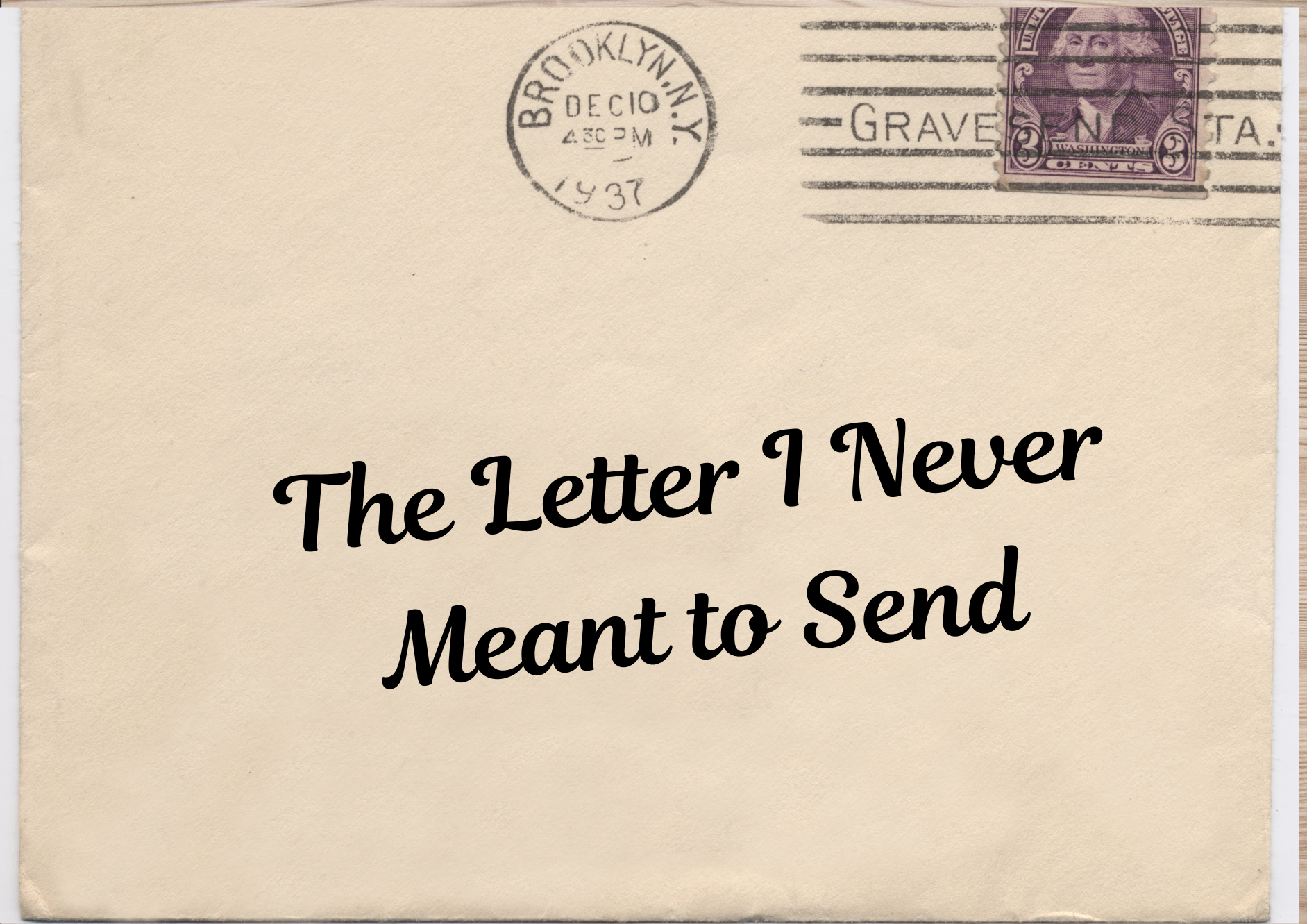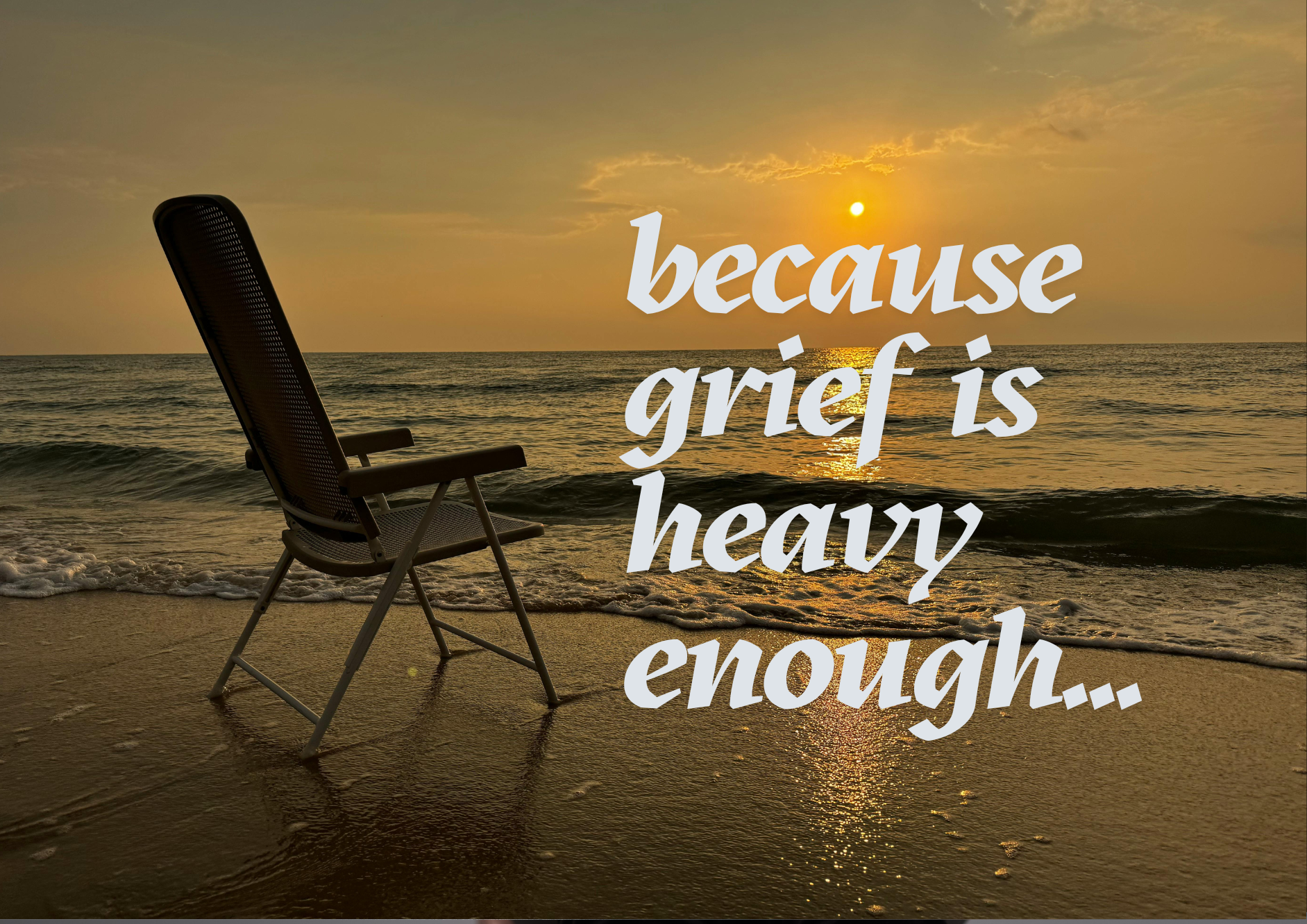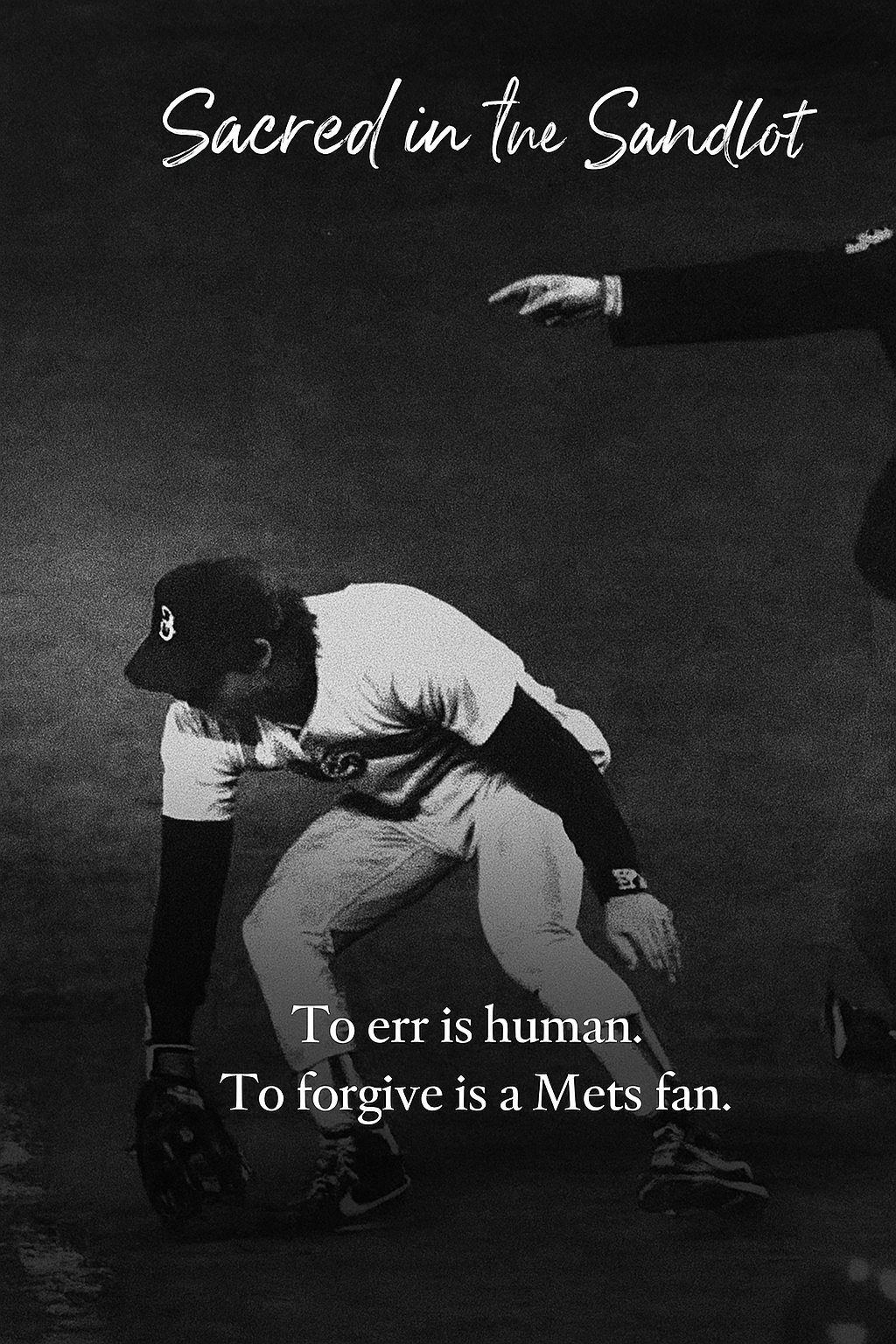Failing into Grace
The Error That Changed Everything
In the 1960s, the Mets were terrible. Not just bad - - lovably, inventively, heartbreakingly terrible. And in the middle of all that losing, one fan kept the faith with a marker and a message. He was known as Sign Man, Karl Ehrhardt. Always seated in the box seats on the third base line at Shea Stadium, derby on his head and a folder full of signs at his feet. He brought 60 to every game, handpicked from a collection of 1,200, each ready for a moment. Some were clever, some were brutal, all were honest.
One of his signs read:
“To err is human. To forgive is a Mets fan.”
I remember seeing him when I was a kid. He was a legend; part cheerleader, part critic, part poet of the bleachers. And that sign? That one stuck with me.
Because baseball is a game of failure. Even the greats fail more than they succeed. Babe Ruth hit 714 home runs - - and struck out 1,330 times. Cy Young won 511 games - - and lost 316. That’s the rhythm of the game: try, fail, recover, repeat.
But not every error gets that kind of turnaround.
Sometimes the error becomes the moment - - the one you carry, the one who have to learn to live with. Just ask Bill Buckner.
Game 6. 1986 World Series. Red Sox vs. Mets. Bottom of the 10th. The ball trickles through Buckner’s legs at first base, and the Mets go on to win. That single play cost him years of peace. Boston needed a villain. Buckner, a solid player with a long career, became the face of failure. He stayed away from Fenway. The city stayed mad.
Until 2004.When the Red Sox finally won the World Series, fans held up a banner that read:
“Forgive Buckner.”
It took 18 years - - but grace caught up.
That’s the thing about errors. They don’t define the whole game. They’re part of it. Part of us. Not just on the field but in the living rooms and hospital rooms and quiet conversations that never quite go the way we hoped. We all make errors.
We speak too quickly, or not at all. We say things we wish we could take back, and leave other things unsaid until it's too late. We mess up relationships, drift from people we love, miss the mark as parents, partners, friends. There are divorces, estrangements, and phone calls we still haven’t returned. And sometimes we wear our errors like a jersey - - as if that one play, that one failure, is the whole story.
Grace remembers differently - - not to condemn, but to redeem. Its voice doesn’t shout; it whispers hope.
Grace is stubborn - - holding your hand through the long nights, offering a clean slate in the morning, and whispering, “You’re still welcome here,”
even after the mess. It’s not just forgiveness, it’s so much more. It’s restoration. A reminder that we are not the sum of our failures, but the beloved bearers of a story still unfolding.
Grace is God’s way of saying, “I see all of you — and I’m not going anywhere.”
Grace shows up not to excuse what happened, but to help you stand up again. It’s the banner in the crowd after 18 long years. It’s the walk-off home run you never saw coming. It doesn’t erase the past, but it refuses to let the worst thing be the last thing.
In The Dark Knight, Alfred says to Bruce Wayne, “Why do we fall? So, we can learn to pick ourselves up.”
That’s grace. Not the absence of failure but the courage to rise again, story still unfolding.
We all miss the grounder. We all make the wild throw. We all have those plays we’d rather forget. But grace doesn’t show up after perfection - it shows up in the middle of the mess.
Sometimes, the most sacred stories begin in failure. Often, the most unlikely altars are built right there - - in the rubble of regret, in the shadow of a mistake, in the space where grace rushes in.
And sometimes, the loudest cheer comes after the biggest mistake.
Just ask a Mets fan.

Every December, the argument returns like a familiar carol sung a little too loud. Is Die Hard a Christmas movie? Some folks hold tight to their cocoa mugs and say, “ No way. ” Others smile the way you smile when the argument is already settled in your heart. I’ve come to believe the debate survives because it isn’t really about explosions or one-liners. It’s about where Christmas actually finds us. When I was preaching, Christmas was rarely quiet. Four or five services on Christmas Eve. Programs to assemble. Bulletins to proof. Candles to count. Microphones to fix. Holy night by way of logistics. I loved the people. I believed the message. But if I’m honest, there were years when I was just muscling through it all, trying to sound joyful while quietly counting the hours until December 26th. Not because I didn’t care. Because I was tired. Christmas had become something I delivered more than something I received. And then, late. After the sanctuaries were dark. After the last “ Merry Christmas ” was said. After the robe was hung back up. Die Hard would sometimes flicker onto the screen. No sermon. No sanctuary. Just a tired preacher on a couch watching a tired man crawl through air ducts, barefoot, scraped up, and refusing to quit. That’s when Christmas found me. First, the setting. Christmas Eve. Office party. Tinsel, teddy bears, and awkward small talk. The soundtrack includes sleigh bells and gunfire, which feels honest if we’re being real about the season. Love arrives on a plane. Redemption arrives barefoot. Second, the plot. A man flies across the country to fix a marriage. He brings a gun, sure, but mostly he brings humility. He learns to say the right name. He learns to ask for help. He learns that reconciliation costs something. If that’s not Advent, I’m not sure what is. Third, the theology of it all. Christmas, at its heart, insists that hope shows up where it shouldn’t. In a stable. In a cubicle farm. In a high-rise named Nakatomi. Grace breaks in during a holiday party and doesn’t bother to RSVP. This is why Die Hard feels like an altar to me. Not a cathedral altar with candles and quiet. An Unlikely Altar . The kind you stumble into while holding snacks. The kind that surprises you with meaning between explosions and one-liners. Because the movie isn’t really about violence. It’s about stubborn love. It’s about a man who keeps crawling through ducts because quitting would be easier, but it would be less faithful. It’s about choosing a relationship over pride. It’s about saying, “ I was wrong, ” and meaning it, even when the building is on fire. And yes, there is a Christmas miracle. Snow falls in Los Angeles. Paper snow, but still. A family is restored. A villain falls. A limo driver gets a tip. The season delivers what it always promises: not perfection, but presence. So, light the tree. Pour something festive. Put Die Hard on the screen and let it preach. Let it remind you that Christmas shows up loud and sideways, that love sometimes limps, and that grace can absolutely wear a tank top. An Unlikely Altar. A Holy night. Yippee-ki-yay, AMEN! 🎄💥

I don’t know your name, but I know this moment. You opened the conversation. You hesitated. And then life stepped in. You know, that happens more often than you might think. I’ve sat at kitchen tables where someone said, “ We meant to do this .” I’ve stood beside families who whispered, “ They kept saying they’d get to it. ” I’ve watched love carry grief—and then watched grief carry bills, decisions, and questions that felt impossibly unfair. This isn’t a letter written to rush you. It’s written because I’ve seen what happens when no one ever circles back. I once stood with a family the morning after a death. The house was quiet in that way only grief can make it. Coffee untouched. Phones buzzing with questions no one wanted to answer yet. Someone finally asked, “ Is there anything in place? ” But there wasn’t What followed wasn’t just sadness. It was scrambling. Credit cards. Awkward conversations. A weight added to a moment already heavy with love and loss. But there are those times when I have seen another scene. I’ve been with families where one small thing was already taken care of. Not everything. Just enough. And in those rooms, grief was still heavy—after all, love always makes it heavy—but it wasn’t tangled up with panic or uncertainty. That’s why this matters to me. Not because I sell final expense insurance. But because I’ve watched what happens when love prepares the way—and when it doesn’t get the chance. If you paused because the conversation felt heavy, I understand. If you paused because life got loud, I understand that, too. If you paused because you told yourself, “ I’ll come back to this ,” I’ve heard that sentence more times than I can count. This isn’t about fear. It’s about care. It’s about peace. It’s about love. Final expense planning isn’t about planning your death. It’s about caring for the people who will still be here when you’re gone. It’s about making sure grief doesn’t have to carry more than it already will. Love will always make grief heavy. A plan simply keeps other burdens from piling on. If you never come back to this conversation, I hope you still hear the heart behind it. And if someday you do return, I hope you know the door was always open. Because this work—this quiet, unseen preparation—is one of the last ways love shows up. And that is no small gift.

The service is over. The thank-you notes have been started. The flowers are starting to fade. Most of the company has travelled home. And the casseroles are stacked in mismatched containers, names written on blue tape. This is what the day after looks like. It’s the morning when the house is too quiet. When the adrenaline wears off. When everyone else has returned to their lives, and you are left standing in the middle of a room, wondering what happens next. Because grief is heavy enough. Not only is the day after quiet, but it is also the kind of silence that invites questions. And those questions can overwhelm you. Who do we call now? What needs to be paid? Is there insurance? Where is the paperwork? What did they want? These questions don’t come because people are being practical. They come because love is trying to keep going in the middle of loss. And because grief is heavy enough, those questions can feel overwhelming. I’ve spent years standing with families in these moments. As a pastor. As a celebrant. As someone who knows that the hardest parts often come after the service ends. I’ve seen families gathered around kitchen tables, coffee gone cold, paperwork spread out in quiet confusion. I’ve also seen something else. I’ve seen what happens when one small thing is already taken care of. Not everything. Just one thing. A simple plan. A clear answer. A quiet assurance that one question does not have to be asked today. Because grief is heavy enough without financial questions layered on top of it. When that piece is in place, something shifts in the room. Shoulders soften. Breathing slows. People are allowed to be exactly what they are in that moment— sad, tired, grieving, human. Final expense planning doesn’t take away grief. Nothing does. But it can take away one weight that doesn’t belong there. Because grief is heavy enough on its own. Planning ahead is not about paperwork or policies. It’s about peace. It’s about leaving behind one less burden for the people you love. It’s about making sure the day after holds space for tears instead of tension. If you’ve ever thought, I should probably take care of this someday, you’re not being morbid. You’re being loving. Because grief is heavy enough. Love will always make it heavy. Planning ahead just keeps other burdens from piling on — so families can grieve without also having to guess. And that is no small gift. If you’d like to talk about what planning ahead could look like for your family—without pressure and at your pace—I’m always here for that conversation. Breathe peace. Marty

